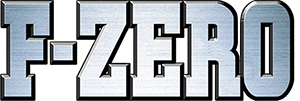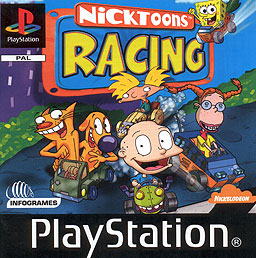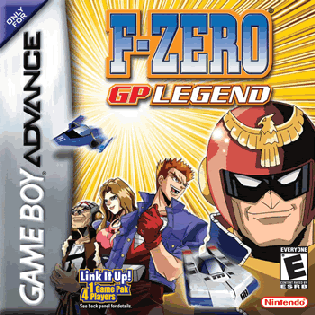
Super Mario Kart is a kart racing game developed and published by Nintendo for the Super Nintendo Entertainment System (SNES). The first game in the Mario Kart series, it was released in Japan and North America in 1992, and in Europe the following year in 1993. Selling 8.76 million copies worldwide, the game went on to become the fourth best-selling SNES game of all time. Super Mario Kart was re-released on the Wii's Virtual Console in 2009, on the Wii U's Virtual Console in 2013, and on the New Nintendo 3DS's Virtual Console in 2016. Nintendo re-released Super Mario Kart in 2017 as part of the company's Super NES Classic Edition.

F-Zero X is a futuristic racing video game for the Nintendo 64 console. Developed and published by Nintendo, it was released in Japan, North America, and Europe in 1998. In 2000, the Expansion Kit was released in Japan, including a track and vehicle editor. The original game was ported in 2004 to the iQue Player in China. It had Virtual Console re-releases on the Wii in 2007 and the Wii U around nine years later. On March 11, 2022, the game was re-released on Nintendo Switch Online + Expansion Pack, featuring online multiplayer.

Excitebike is a motocross racing video game developed and published by Nintendo. In Japan, it was released for the Famicom in 1984 and then ported to arcades as Vs. Excitebike for the Nintendo Vs. System later that year. In North America, it was initially released for arcades in 1985 and then as a launch game for the Nintendo Entertainment System later that year, becoming one of the best-selling games on the console. It is the first game in the Excite series.

F-Zero is a series of futuristic racing games published by Nintendo, developed by Nintendo EAD and other third-party companies. The first game was released for the Super Famicom in Japan in 1990. Its success prompted Nintendo to create sequels on subsequent consoles.

F1 Race is a racing video game developed by HAL Laboratory and published by Nintendo for the Famicom in 1984. A version was released in 1990 for the Game Boy in Japan and in 1991 in Europe and North America, including the Four Player Adapter for four-player gameplay.
Mario Kart Arcade GP is sub-series of arcade game's from Nintendo's Mario Kart series developed specifically for arcades in collaboration with Namco To date, four entries have been released - Mario Kart Arcade GP (2005), Mario Kart Arcade GP 2 (2007), Mario Kart Arcade GP DX (2013), and Mario Kart Arcade GP VR (2017). The first three entries are considered to be relatively rare outside of Japan, with the fourth title not seeing a release outside of Japan at all. The game's have been generally been well-received by critics, who have praised the game's transition of traditional Mario Kart gameplay into an arcade game format, thought to-date, while lamenting that none of the entries have been released outside of the arcade format onto any of Nintendo's home video game consoles.

Tourist Trophy is a 2006 motorcycle racing game. It was designed by Polyphony Digital, the developers of the popular Gran Turismo auto racing series. Tourist Trophy is one of only four titles for the PlayStation 2 that is capable of 1080i output, another being Gran Turismo 4, the game engine of which is also used by Tourist Trophy, therefore serving as a spin-off title to the Gran Turismo series.

Jeep Jamboree: Off Road Adventure is a Game Boy racing video game that involves Jeep Wrangler vehicles. This game was later recycled for use in the video game Race Days.

Genki Co., Ltd. is a Japanese video game developer. It was founded in October 1990 by Hiroshi Hamagaki and Tomo Kimura, who left Sega to form the company. The company is best known for its racing game titles.

Scud Race is an arcade racing video game released by Sega in 1996. It is the first racing game to use the Sega Model 3 hardware. Despite being released well within the lifetime of the Sega Saturn, no Saturn port was ever released. A Dreamcast port was announced for the system's 1998 launch lineup and was shown as a tech-demo in the Dreamcast Presentation in 1998, but was cancelled.

Tokyo Xtreme Racer is an arcade racing video game series created by Genki and inspired by street racing on the Shuto Expressway in Tokyo. Its first installment, Shutokō Battle '94: Drift King, released in 1994 for the Super Famicom. In 2017, Genki released the latest installment of the series, Shutokou Battle Xtreme, for iOS and Android devices.

Ayrton Senna's Super Monaco GP II is an arcade-style Formula One racing video game developed and manufactured by Sega for the Sega Genesis and Mega Drive, Master System, and the Game Gear in 1992. It is a follow-up to Super Monaco GP. The game was also endorsed by, and had technical input from, the then-Formula One champion Ayrton Senna. Gameplay includes a World Championship season featuring recreations of the tracks in the 1991 Formula One World Championship, along with a three-race "Senna GP" mode set on fictional tracks.

Sonic Riders: Zero Gravity is a hoverboard racing video game developed by Sonic Team and published by Sega for the PlayStation 2 and Wii. It is the fifth pure racing game in the Sonic the Hedgehog series, and the second entry in the Sonic Riders trilogy, a spin-off of the main series.

Nicktoons Racing is a Nickelodeon crossover racing video game. The game was first developed by Pipe Dream and released for the Game Boy Color, while versions for different platforms were released in subsequent years. Most versions were developed by Software Creations with the exception of the Game Boy Advance version, which was developed by Crawfish Interactive, and the arcade version, which was developed by Chicago Gaming.

Cyber Spin is a futuristic racing video game that was released in 1992 to Japan and North America for the Super NES. It is known in Japan as Shinseiki GPX: Cyber Formula which is based on the anime Future GPX Cyber Formula, and because of that, it has the proper license to use the characters from the anime.

2Xtreme is a racing game released for the PlayStation in 1996 and a sequel to ESPN Extreme Games. Unlike the original, the game does not bear ESPN licensing. In it, the player races against others in various events around the world using Rollerblading, skateboarding, biking, and snowboarding. A sequel, 3Xtreme, was released in 1999.

GP-1: Part II, known in Japan as GP-1 RS: Rapid Stream is a motorcycle racing game developed by Genki and published by Atlus for the SNES, which was released in 1994. It is a sequel to GP-1.

Fastest 1 (ファステスト・ワン) is a Sega Mega Drive racing game video game released in 1991 exclusively in Japan. During the release of this video game, other Formula One video games like Super Monaco GP had caused a general increase of demand for Formula One video games. While most of those games were poor simulations of the races, Fastest One proved to be the most realistic of the era.

Moto Racer Advance is a motocross racing game developed by Adeline Software International, produced by Delphine Software International and published by Ubisoft for the Game Boy Advance. It was released in 2002 in PAL regions on October 4 and in North America on December 4. It is part of the Moto Racer series and was the last game to be developed by Adeline Software and also the last with any involvement from Delphine Software.

F-Zero: GP Legend is a futuristic racing video game for the Game Boy Advance handheld. Developed by Suzak Inc., it was released in Japan in 2003, and in Europe and North America in 2004.

















